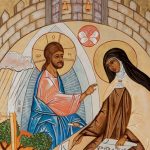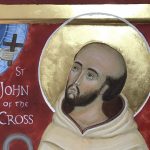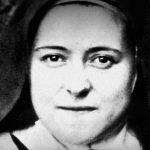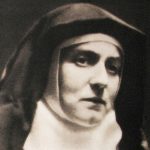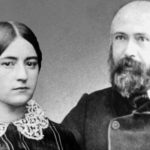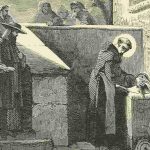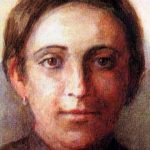Saint John of the Cross
Saint John of the Cross who is well known for his mystical writings and poetry, was closely associated with Saint Teresa in her work of founding the reformed Carmel.
Juan de Ypes was born at Fontiveros in Spain in 1542 into a poor and struggling family. The death of his father soon afterwards and the lack of family support for his mother meant that he was no stranger to destitution. In fact, one of his brothers died in childhood, probably from malnutrition. John's life was marked by suffering but he knew the security of the genuine selfless love of his mother and elder brother, Francisco.
His meeting with St Teresa when he was a young Carmelite friar led him to abandon his plan to join the Carthusian Order for a stricter way of life and wholeheartedly give himself to this new venture of St Teresa's. It was exactly what he was longing for and he, with two companions, began the first monastery of the Teresian reform for the friars at Duruelo.
As the movement grew he experienced hostility from his former brother friars who objected to this reform seeing it as a criticism of their own more lax way of life. He was imprisoned in a dungeon in Toledo but eventually – and dramatically – managed to escape. From his prison experience flowed some of his most exquisite poetry, the fruit of all the hours of silent prayer he spent in that unlikely place of darkness and cruelty.
From the depths of this darkness he cried out to Christ his Lord:
Beloved, in you I find
The mountains, wooded vales;
Choice islands, distant, strange.
The river's voice resounds
with ever-changing flow.
As whisper soft of breeze
now sings our love.
Deepen your spiritual journey with St John of the Cross
Fr Tadgh Tierney, a Carmelite friar from Infant Jesus Parish in Morley, Australia, has written a wonderfully soul-nourishing booklet in which he summarises the spiritual wisdom in each of St John of the Cross's works. It's enriching, inspiring, and FREE! Click here to get the booklet!
And below is an insightful short clip about St John of the Cross and his message for us today.
Principal Events in the Life of Saint John of the Cross
1542 — Born Juan de Yepes at Fontiveros, near Avila, Spain.
1563 — John took the habit of the Carmelite Friars in Medina.
1564 — Made Profession as a Carmelite, then entered the University Salamanca to study arts and theology.
1567 — Ordained a priest. Later that year he met St. Teresa at Medina then returned to University at Salamanca.
1568 — 28 November John took the vows of the Reform at Duruelo.
1577 — On the night of December 2, John is kidnapped by the Carmelites of the Ancient Observance and carried off to the Carmelite priory at Avila. After a short time he is taken prisoner to the priory at Toledo.
1577-8 — In Toledo prison, John begins writing poetry to express his inner spirit and for his own consolation.
1578 — Sometime in August John escapes to the convent of the Discalced Carmelite nuns in Toledo. In October, John attends a meeting of the Discalced superiors at Almodovar. They decide to send him to El Calvario as Vicar.
1578-9 — During his time at El Calvario he begins his commentary entitled Ascent of Mount Carmel.
1579 — John founds a college of the Reform at Baeza and remains as rector for the next three years. During this time he continues his ministry of the written word.
1581 — John attends the Alcala Chapter of the Reform, arriving on March 3 or 4. He is appointed third definitor and prior of the Granada house of Los Martires. In November John meets St. Teresa Avila. This was to be their last meeting.
1582 — Toward the end of January, John arrives at Los Martires in Granada. He is elected prior, and continues his writing-including the last five stanzas of the “Spiritual Canticle” poem (with it commentary), the finishing touches on the Ascent of Mount Carmel, and the whole of the LivingFlame of Love.
1585 — In May, the Lisbon Chapter appoints John second definitor and vicar
1587 — In April, the chapter of Valladolid re-appoints John prior of Los Martires.
1588 — In August, John attends the chapter of the Reform in Madrid, and is elected first definitor. Later that month, John takes up his new role as prior of Segovia, the house that would become the headquarters for the government of the Reform. John acts as deputy for Fr. Doria, during the latter’s absences.
1590 — In June, John is re-elected first definitor at the extraordinary chapter held in Madrid.
1591 — On June 1, the eve of Pentecost, the general chapter opens in Madrid. John is left without office and sent to La Penuela to prepare for assignment to Mexico. He arrives at La Penuela in August. Within a few weeks, John falls victim to severe fever. On September 22 he leaves La Penuela for Ubeda. John of the Cross dies at Ubeda on December 14.
Icon of St John of the Cross written by Australian Carmelite and icongrapher Mary Clancy

